A Survey of Mobile Cloud Computing: Architecture, Applications, and Approaches
A Survey of Mobile Cloud Computing: Architecture, Applications, and Approaches. Introduction. Mobile devices Mobile computing(MC) Challenges with resources and communication Cloud computing(CC) MC + CC = Mobile cloud computing(MCC) Definition, architecture, advantages
Share Presentation
Embed Code
Link
Download Presentation
- web interface
- processing power
- task scheduling
- wirelessman
- centralized computing platform
- wireless link betn user

amie + Follow
Download Presentation
A Survey of Mobile Cloud Computing: Architecture, Applications, and Approaches
An Image/Link below is provided (as is) to download presentation Download Policy: Content on the Website is provided to you AS IS for your information and personal use and may not be sold / licensed / shared on other websites without getting consent from its author. Content is provided to you AS IS for your information and personal use only. Download presentation by click this link. While downloading, if for some reason you are not able to download a presentation, the publisher may have deleted the file from their server. During download, if you can't get a presentation, the file might be deleted by the publisher.
Presentation Transcript
- A Survey of Mobile Cloud Computing: Architecture, Applications, and Approaches
- Introduction Mobile devices Mobile computing(MC) Challenges with resources and communication Cloud computing(CC) MC + CC = Mobile cloud computing(MCC) Definition, architecture, advantages Use of MCC in applications Issues in MCC and how to address them Future research A Survey of Mobile Cloud Computing
- What is Mobile Cloud Computing? Infrastructure Storage and computing Centralized computing platform Access for a broad range of users Less demanding for mobile device A Survey of Mobile Cloud Computing
- Architecture of MCC A Survey of Mobile Cloud Computing
- Cloud Architecture A Survey of Mobile Cloud Computing
- Advantages of MCC Extended battery lifetime Data storage capacity Processing power Improving reliability Dynamic provisioning Scalability Multitenancy Ease of integration A Survey of Mobile Cloud Computing
- Applications of Mobile Cloud Computing Mobile commerce Business model Three classes: Finance, Advertising and Shopping Various challenges Mobile learning Electronic learning Limitation in traditional m-learning applications A Survey of Mobile Cloud Computing
- Applications of Mobile Cloud Computing Mobile healthcare Decrease treatment time Access medical records Patient monitoring/health-aware Coordinate resources Mobile gaming Offload game engine computations MAUI Other practical applications A Survey of Mobile Cloud Computing
- Issues and Approach of MCC Integrating two technologies Low bandwidth Availability Heterogeneity A Survey of Mobile Cloud Computing
- Issues and Approach of MCC Computing offloading In static environment Efficiency of offloading Partitioning Components in java program Data size and execution time Online statistics In dynamic environment Re-offload failed subtasks Three step to application structuring Three step using MAUI with code portability A Survey of Mobile Cloud Computing
- Issues and Approach of MCC Security Mobile users Mobile applications Privacy A Survey of Mobile Cloud Computing
- Issues and Approach of MCC Security Data on clouds Integrity Authentication Digital rights management A Survey of Mobile Cloud Computing
- Issues and Approach of MCC Enhancing the efficiency of data access A Survey of Mobile Cloud Computing
- Issues and Approach of MCC Enhancing the efficiency of data access Pocket cloudlet Random file structure A Survey of Mobile Cloud Computing
- Issues and Approach of MCC Context-aware mobile cloud services Mobile Service Clouds Service cloud paradigm Service gateway Framework for providing context-aware mobile services Based on algorithm Consider several contexts A Survey of Mobile Cloud Computing
- Issues and Approach of MCC A Survey of Mobile Cloud Computing
- Open issue and future research directions Low bandwidth Dramatic increase of mobile and cloud user 4G Network and Femto cell might be promising solution to overcome bandwidth limitation 4G network Significantly increases bandwidth capacity 100 Mbits/s(LTE advanced standard) and 128 Mbits/s (WirelessMAN-advanced), 14.4Mbits/s(3G) Improves mobile coverage area,smoothering quicker handoff ,varied services.
- Open issue and future research directions • Femtocell • Small cellular base station (used in a small area) • Hay Systems Ltd (HSL) develops service to combine femtocell and CC, provide highly secure, economical and scalable network • Connects via internet to cloud to gain access to their operator networks • Mobile operators connect with cloud enabling their subscribers to gain access to their network when using femtocell connected to the cloud • Coverage is likely to be consistent and has capacity to limit the how many people are permitted to log on.
- Open issue and future research directions • Network access management • Improves bandwidth coverage besides the link performance • Cognitive radio is a possible solution • Increases the efficiency of the spectrum utilization • Allow unlicensed user to use spectrum allocated for licensed users. (solves spectrum scarcity saves millions dollars of network provider) • Based on recognition of radio resource availability in heterogeneous wireless environment • MCC user should be able to perceive the radio availability without interference with traditional services.
- Open issue and future research directions • Quality of service • Congestion due to limited wireless bandwidth, network disconnection, signal attenuation caused by user’s mobility (degrades QoS significantly) • Clone cloud and cloudlets might be promising solution to reduce network delay • Clone cloud • Brings power of CC on mobile • Mechanism to clone the entire set of data and app on to the cloud and communicate with copy of own • Execute operation on the clone and re-integrate the result back to the phone.
- Open issue and future research directions • Quality of service • Cloudlets • Resource enriched computer or cluster of computer well connected to internet • Can be used by nearby mobile device • If user do not want to offload on cloud can use cloudlets and avoid communication delay
- Open issue and future research directions • Pricing • Using MCC service involves both MSP and CSP • How the price will be divided among different entities • Example user playing game (gaming application) • Has to pay game service provider, MSP and CSP • How the price paid by game player is divided among them • The business model should be carefully designed for pricing and revenue sharing
- Open issue and future research directions • Standard Interface • Mobile user interact and communicate with cloud via web interface which is not ideal way • The HTML 5 can be promising solution • HTML 5 Websockets offers good interface • Extensive performance evaluation and feasibility study is required to ensure it works well with MCC
- Open issue and future research directions • Service convergence • Single cloud may not meet users demand • Mobile user can utilize a multiple clouds in unified fashion • Sky computing is a potential solution • Sky cloud computing will give platform for user to use cross-cloud computing and use mobile services and application • To offer service to user in unified way the service integration need to be explored
- Cloud Structure with mobile wireless device • Cloud is brought closer to the users to avoid communication latency of Internet • Best leverage cloud Resource to execute mobile applications
- Cloud Structure with mobile wireless device • Local cloud and Back–end cloud • LTE Base stations or WiFi access points for accessing cloud • Back-end cloud facility of servers interconnected with wire links • Access to Back –end cloud from mobile client via wireless link • Small sized local cloud placed at point of wire less access
- Cloud Structure with mobile wireless device • Local cloud and Back-end cloud connected and controlled by same provider • Vm migration to balance the load at each server
- Lifetime of a Task in the Cloud • Total time spent by task in the cloud • Stages of the task • Upload • Task Assignment • Execution • Migration • Download
- The state evolution of a task during its lifetime
- Lifetime of a Task in the Cloud • Upload • When new task generated • Source code and input data uploaded to cloud via wireless link betn user and corresponding point of wireless access • Vm initialization • Either executed in the local cloud or forwarded over internet to back-end cloud
- Lifetime of a Task in the Cloud • Task Assignment • Once data uploaded to data center • Local dispatcher assigns server for the task • Vm is created for task and assigned to physical server • Execution • Real processing within the cloud • New vmintialized for task and immediate execution
- Lifetime of a Task in the Cloud • Migration • Transfer of Vm from current server to new one • Occur multiple time • Accompanying data volume transferred for new vminitialization • Download • Retrieval of the final result by mobile user • Once computation finished result downloaded by user immediately using its current technology • Host not in wireless range of mobile user, data transferred to accessible server • die(); // kernel oops
- Issues on Task scheduling and migration in the cloud • Task placement and performed by Vm manager • Task placement helps to balance load at each server to some extent • Cannot guarantee the Quality of Service (QoS) due highly volatile cloud • Task migration a promising option provides fine tuned means of balancing load throughout the system • But Vm migration induces delay (should be accounted) • Stop execution of vm at current server • Move accompanying data to new server • Initialize new vm • Cloud providers faces inherent tradeoff in selecting optimal migration strategy • Optimization of clients QoE, reducing execution time • Reduced execution time better for computing with other providers rises larger residual processing capacity • Fully exploit the task consolidation to reduce operating cost(turning off the underutilized servers.)
- Issues on Task scheduling and migration in the cloud • When to migrate and where? • QoS is being violated for long time • Execution time at new server is smaller than current • Information about the current server and tentative server is required • Efficient Vm Scheduling for accurate prediction of multi tenancy cost. • Prior knowledge of resource pattern for each task is required for modeling contention • Extensive profiling of different types of cloud; characterization through profiling impractical as significantly diverse task exists in cloud • Multi tenancy cost estimated through online measurement when task being executed (suggestion)
- Issues on Task scheduling and migration in the cloud • The task generate new data as time passes • The Vm characterized by time varying volume of accompanying data • May increase decrease or remain same over time • Video compression , complex scientific complex calculation • The challenge stem form • Highly dynamic nature, user mobility, continuously evolving population at servers • Time varying processing capacity of server due to multitenancy, evolving accompanying data of each vm
- Challenges in Designing efficient Migration Mechanism for the cloud • Workload uncertainty • Unpredictability of multitenancy effects • Unknown evolution of accompanying data volume • Time varying network link capacity • Partial availability of cloud related information
- Modes of Task Migration • Centralized Migration policy • Server Initiated Migration: Towards reducing the complexity of migration decision • Task-Autonomic Migration
- Centralized Migration policy • From the provider point of view efficient migration mechanism maximize the performance of whole system • Tasks moved from overloaded server to underutilized servers • Three dimensional space search for selecting optimal migration strategy • For each server of the system, for each of its tasks the performance gain of migration to candidate servers should be estimated
- Centralized Migration Policy flow chart
- Centralized Migration policy • For efficient migration strategy following things are taken into account • Data volume • Residual processing burden • Multitenancy • Mobility
- Server initiated migration • Distributed migration mechanism • Server enable to decide for migration of its active task • Migration initiated when server overloaded and about to violate SLA • 2 dimensional search • For each active task anticipated gain for each possible migration to new server ; maximum gain selected • Impact of migration on destination not accounted(aggerate reduction of hosted task+migrating task)
- Task-autonomic migration • Distributed migration • Initiated by task itself ( instead of delegating cloud) • Migration done when beneficial execution time including migration delay. • Extreme competition for least loaded servers.
- Characteristics of different mode of migrations
- Evaluation of migration benefits and impact of mobility Indicative migration of mobile task throughout its lifetime under three scenarios.
- Evaluation of migration benefits and impact of mobility f
- Evaluation of migration benefits and impact of mobility f
- Evaluation of migration benefits and impact of mobility f
- Future challenges and open direction • Energy efficiency consideration of Task Migration • Server load migration and Integration of Renewable Sources • Impact of Multitenancy • Modeling Future cloud Ecosystems
- Energy efficiency consideration of task migration • Critical issue in large data center with many dispersed servers • Energy consumption> number of active servers > increasing server load • Task migration saves energy consumption by reducing no of the active servers or by reducing energy consumption of individual server • Contradiction • Relative amount of energy consumption of servers when idle or loaded and dependence of energy consumption on a physical machine load • Derive analytical model
- Server load migration and integration of renewable sources • General policy is to build co-located renewable energy source for minimization of dependence with main power grid • o/p of these sources stochastic and time varying • Task migration on data center changes power demand. • Balance the power supply and demand by migration control Load More .

Grid Architecture for eLearning
Grid Architecture for eLearning Eric Yen Computing Centre, Academia Sinica Jan. 22th, 2003 Outline Emergence of eLearning Why using Grid for eLearning? Related Work in the World Our Approaches Future Development and Conclusion The Unprecedented Ten Years Networking from 100Kbps to Gbps
1.13k views • 51 slides
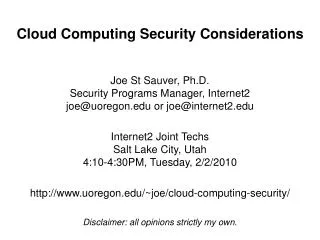
Cloud Computing Security Considerations
Cloud Computing Security Considerations. Joe St Sauver, Ph.D. Security Programs Manager, Internet2 joe@uoregon.edu or joe@internet2.edu Internet2 Joint Techs Salt Lake City, Utah 4:10-4:30PM, Tuesday, 2/2/2010 http://www.uoregon.edu/~joe/cloud-computing-security/
1.03k views • 40 slides
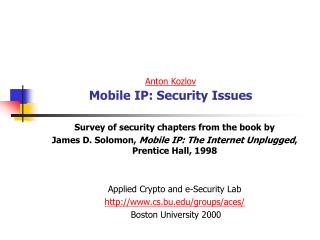
Anton Kozlov Mobile IP: Security Issues
Anton Kozlov Mobile IP: Security Issues. Survey of security chapters from the book by James D. Solomon, Mobile IP: The Internet Unplugged , Prentice Hall, 1998 Applied Crypto and e-Security Lab http://www.cs.bu.edu/groups/aces/ Boston University 2000 . Current State of Mobile Computing.
1.47k views • 74 slides
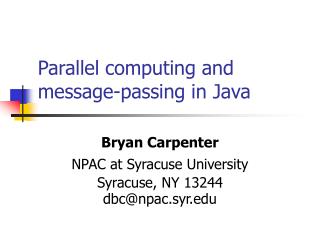
Parallel computing and message-passing in Java
Parallel computing and message-passing in Java. Bryan Carpenter NPAC at Syracuse University Syracuse, NY 13244 dbc@npac.syr.edu. Goals of this lecture. Survey approaches to parallel computing in Java. Describe a Java binding of MPI developed in the HPJava project at Syracuse.
1.22k views • 91 slides

An Overview of Cloud Computing Raghu Ramakrishnan Chief Scientist, Audience and Cloud Computing Research Fellow, Yahoo!
An Overview of Cloud Computing Raghu Ramakrishnan Chief Scientist, Audience and Cloud Computing Research Fellow, Yahoo! Research. Reflects many discussions with: Eric Baldeschwieler, Jay Kistler, Chuck Neerdaels, Shelton Shugar, and Raymie Stata
959 views • 65 slides
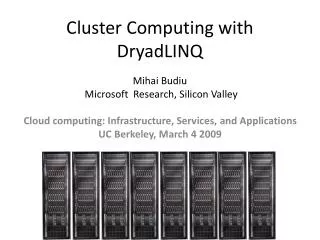
Cluster Computing with DryadLINQ
Cluster Computing with DryadLINQ. Mihai Budiu Microsoft Research, Silicon Valley Cloud computing: Infrastructure, Services, and Applications UC Berkeley, March 4 2009. Goal. Design Space. Grid. Internet. Data- parallel. Dryad. Search. Shared memory. Private d ata center.
874 views • 68 slides
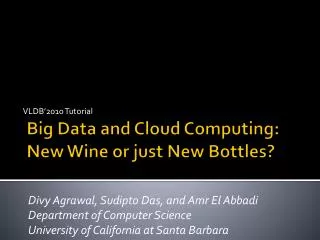
Big Data and Cloud Computing: New Wine or just New Bottles?
VLDB’2010 Tutorial. Big Data and Cloud Computing: New Wine or just New Bottles?. Divy Agrawal, Sudipto Das, and Amr El Abbadi Department of Computer Science University of California at Santa Barbara. Outline. Data in the Cloud Data Platforms for Large Applications Key value Stores
976 views • 77 slides
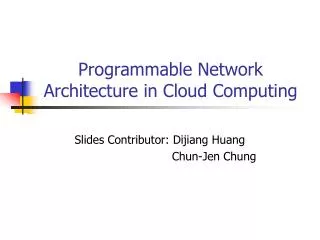
Programmable Network Architecture in Cloud Computing
Programmable Network Architecture in Cloud Computing. Slides Contributor: Dijiang Huang Chun-Jen Chung. Agenda. Overview of Virtualization Overview of Virtual Networking Solutions Overview of OpenFlow Switch and Programmable Networking
1.38k views • 78 slides
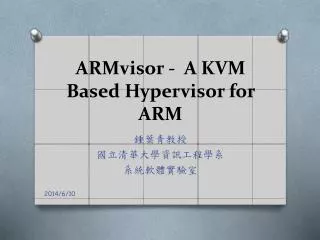 A KVM Based Hypervisor for ARM" width="320px" />
A KVM Based Hypervisor for ARM" width="320px" />
ARMvisor - A KVM Based Hypervisor for ARM
ARMvisor - A KVM Based Hypervisor for ARM. 鍾葉青教授 國立 清華大學資訊 工程學系 系統軟體實驗室. Outline. The Trend of Mobile Virtualization Design and Implementation of ARMvisor Mobile Virtualization Examples ARM-based Server for Cloud Computing Conclusions. The Trend of Mobile Virtualization.
1.62k views • 76 slides
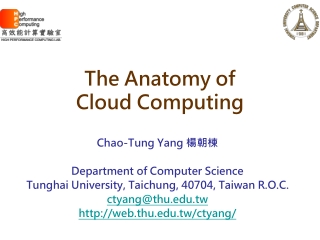
The Anatomy of Cloud Computing
The Anatomy of Cloud Computing. Chao-Tung Yang 楊朝棟 Department of Computer Science Tunghai University, Taichung, 40704, Taiwan R.O.C. ctyang@thu.edu.tw http://web.thu.edu.tw/ctyang/. Outline. Infrastructure Software Services Applications Summary. Cloud. Why we use cloud computing?.
2.37k views • 113 slides
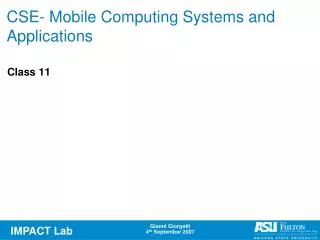
CSE- Mobile Computing Systems and Applications
CSE- Mobile Computing Systems and Applications. Class 11. Announcements. Phase 2 and 3 requirements uploaded Please return the motes to TA after class today Come up with topics and reference papers by 10/3/2011. Agenda. Concurrent Execution in TinyOS Sensor Networks and Localization.
949 views • 75 slides
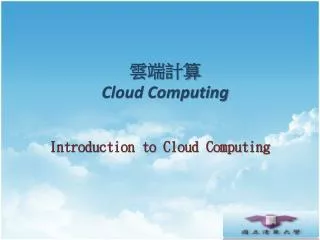
雲端計算 Cloud Computing
雲端計算 Cloud Computing. Introduction to Cloud Computing. Agenda. What is Cloud Computing ? Different perspectives Properties and characteristics Benefits from cloud computing Service and deployment models Three service models Four deployment models. What do they say ?.
1.53k views • 122 slides
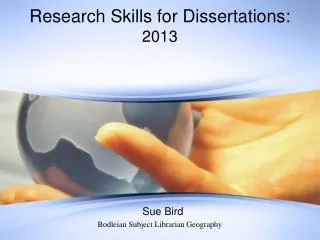
Research Skills for Dissertations: 2013
Research Skills for Dissertations: 2013. Sue Bird Bodleian Subject Librarian Geography. Cloud computing. Oxford Libraries Information Platform. Cloud computing. e -Journals e-Books. Literature & Data Search E ngines. The digital architecture facilitating research & study .
1.36k views • 125 slides
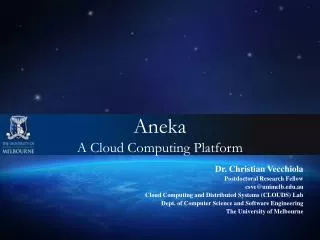
Aneka A Cloud Computing Platform
Aneka A Cloud Computing Platform. Dr. Christian Vecchiola Postdoctoral Research Fellow csve@unimelb.edu.au Cloud Computing and Distributed Systems (CLOUDS) Lab Dept. of Computer Science and Software Engineering The University of Melbourne. Outline. Cloud Computing Aneka Architecture
6.19k views • 33 slides

CS43 4 /53 4 : Mobile Computing and Wireless Networks zoo.cs.yale/classes/cs43 4/
CS43 4 /53 4 : Mobile Computing and Wireless Networks http://zoo.cs.yale.edu/classes/cs43 4/. Y. Richard Yang 08 /30/2012. Outline. Pervasive wireless networks and mobile applications Challenges facing wireless networks and mobile computing Course information. Goal of Mobile Computing.
924 views • 71 slides
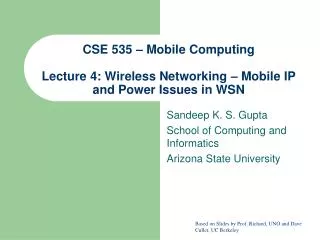
CSE 535 – Mobile Computing Lecture 4: Wireless Networking – Mobile IP and Power Issues in WSN
CSE 535 – Mobile Computing Lecture 4: Wireless Networking – Mobile IP and Power Issues in WSN. Sandeep K. S. Gupta School of Computing and Informatics Arizona State University. Based on Slides by Prof. Richard, UNO and Dave Culler, UC Berkeley. Agenda and Reading from Book.
962 views • 71 slides

UNIT - I Mobile Communication and Mobile Computing
UNIT - I Mobile Communication and Mobile Computing. Motivation. Speech- and Data Communication location independent and mobile Ä New application areas, flexibility, improved workflows Requirements: - Mobile end-devices - Radio transmission - Localization and signalization/management
5.43k views • 415 slides
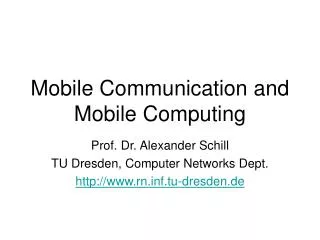
Mobile Communication and Mobile Computing
Mobile Communication and Mobile Computing. Prof. Dr. Alexander Schill TU Dresden, Computer Networks Dept. http://www.rn.inf.tu-dresden.de. Contents. 1. Motivation 2. Mobile Communication History Principles Media Access Methods Mobile Radio Networks: Overview GSM HSCSD, GPRS UMTS.
4.74k views • 418 slides

Cloud Computing
Cloud Computing. Appunti sul panorama del Cloud Computing attuale e ipotesi di contestualizzazione con il Framework di Riferimento CSI. Relatore Direzione / Area CSI. Principi del Cloud Computing. Tassonomia e principali definizioni. Tassonomia. Cloud Computing Use Cases White paper 3.0
976 views • 69 slides

第七章 云计算与移动多媒体广播 Chapter 7 Cloud Computing and CMMB
第七章 云计算与移动多媒体广播 Chapter 7 Cloud Computing and CMMB. 电控学院 电子工程学科部 司鹏搏 综合楼 825 室 sipengbo@bjut.edu.cn. Main Contents. 7.1 Cloud Computing 7.1.1 One of the Most Promising Technologies 7.1.2 Major Players of Cloud Computing 7.1.3 What is Cloud Computing? 7.1.4 IaaS 7.1.5 PaaS
1.03k views • 79 slides

Resource Allocation in Cloud Computing
Resource Allocation in Cloud Computing. Resource Allocation. How to maximize resources in order to most effectively provide cloud computing services. Presentation Plan. Distributed Clouds and their Challenges IaaS Resource Allocation based on pre-known demands
2.79k views • 120 slides











 A KVM Based Hypervisor for ARM" width="320px" />
A KVM Based Hypervisor for ARM" width="320px" />










